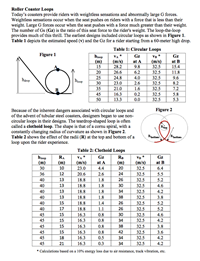 Roller Coaster Loops
Roller Coaster Loops
Resource:
The Science Reasoning Center: Roller Coaster Loops
Grade Level: High School
Description:
This passage presents data that compares a circular loop and a clothoid loop on a roller coaster, thus comparing the effect of loop shape, loop radius and initial drop height upon the speed and the G forces experienced by riders at the top and the bottom of the loops. Data is presented in the form of two figures and two data tables. Questions target a student's ability to identify the effect of one variable upon another variable, to compare data points from different tables, to interpolate and to extrapolate from data in a table, to draw conclusions that are consistent with the provided data, and to use provided data to evaluate the safety issues surrounding projected loop designs.
Performance Expectation:
HS-PS3-2: Develop and use models to illustrate that energy at the macroscopic scale can be accounted for as a combination of energy associated with the motions of particles (objects) and energy associated with the relative positions of particles (objects).
This activity aligns with the three dimensions of the Next Generation Science Standards in the manner described below:
Conservation of Energy and Energy Transfer (HS-PS3.B.3): Mathematical expressions, which quantify how the stored energy in a system depends on its configuration (e.g. relative positions of charged particles, compression of a spring) and how kinetic energy depends on mass and speed, allow the concept of conservation of energy to be used to predict and describe system behavior.
|
While much of this passage explores the effects of rollercoaster loop shape (circular vs. clothoid) on the acceleration experienced by riders, data found in Tables 1 and 2 are based on the conservation of mechanical energy. Students compare and contrast data from two rollercoaster loop designs to see what effect (if any) loop radius and loop height have on coaster speed and acceleration. In addition to conservation of energy concepts, this passage also explores the concept of centripetal acceleration and factors that affect its magnitude. |
| Energy and Matter: The total amount of energy and matter in closed systems is conserved. |
As a cross-cutting concept, conservation of energy is at the core of the data presented in this passage. While every branch of science utilizes this important principle in making predictions about systems being studied, the rollercoaster is great example of how this principle can make predictions about a coaster’s motion along the track. |
Structure and Function: Investigating or designing new systems or structures requires a detailed examination of the properties of different materials, the structures of different components, and connections of components to reveal its function and/or solve a problem.
|
This passage explores how the shape of rollercoaster loops has changed from a circular loop to that of a clothoid shape in order to increase an object’s centripetal acceleration at the top of the loop. Two data tables allow the reader to see how rollercoaster engineers have come to the conclusion that this slight change in loop shape provides both a greater thrill and enhances a rider’s safety. |
| Analyzing and Interpreting Data: Evaluate the impact of new data on a working explanation and/or model of a proposed process or system. |
Earlier designs of rollercoaster loops used a circular shape. This passage provides speed and acceleration data experienced by passengers using this traditional loop shape both at the bottom and top of the loop. The passage then asks the reader to evaluate the impact of the newer clothoid shape on a passenger’s speed and acceleration. The reader will in turn consider how this impacts the rider’s thrill and safety. |
| Constructing Explanations and Designing Solutions: Apply scientific principles and evidence to provide an explanation of phenomena and solve design problems, taking into account possible unanticipated effects. |
Roller coaster engineers have explored the impact of changing the shape of a coaster’s loops on thrill and safety. In this passage and the subsequent questions, the student is asked to serve as both the scientist and engineer by applying science principles and evidence from data sets to provide an explanation of why the clothoid shape is preferred over the circular shaped loop. |
| Using Mathematical and Computational Thinking: Use mathematical and/or computational representations of phenomena or design solutions to support explanations. |
“What effect does changing ______ have on ______?” is an important and familiar question in the analysis of any data. The first set of questions at the end of this passage requires the reader to employ computational thinking in considering how changing a coaster’s height and loop radius affects one’s speed and acceleration. |
Associated Reading from The Physics Classroom
Other Supporting Pages at The Physics Classroom:
- The Curriculum Corner: Circular Motion and Inertia; The Centripetal Force Requirement: and Mathematics of Circular Motion
View Infographic.
(Coming Soon)
Search the NGSS Corner
Maybe you're looking for something really specific that pertains to a desired topic and emphasizes one or more of the listed NGSS dimensions. Why not try a search of this section of our website? Simply select from one or more of the pull-down menus and click Search This page will reload and a collection of possibilities will be displayed in this section of the page and sorted by relevancy.